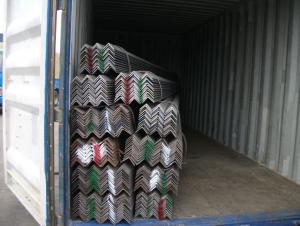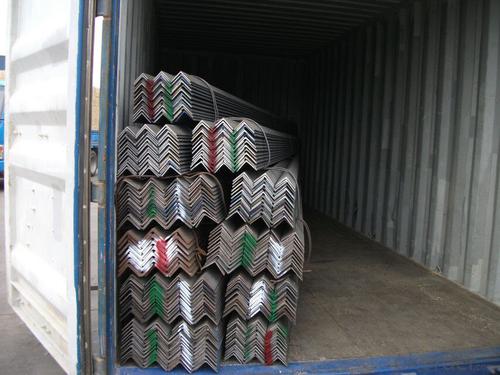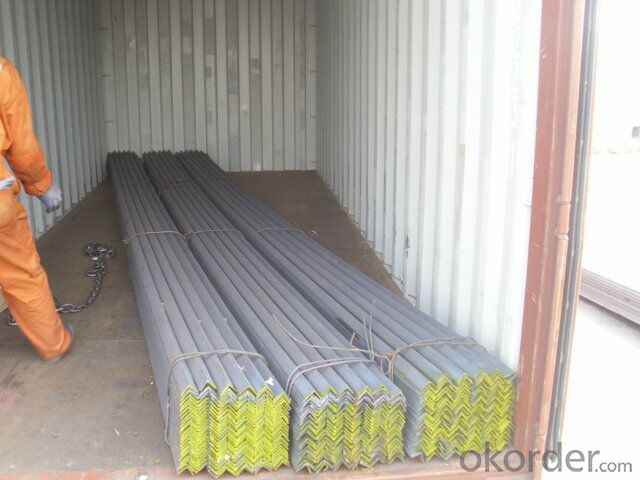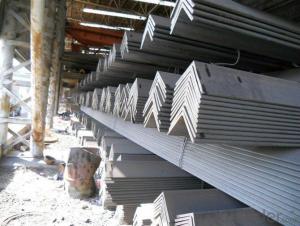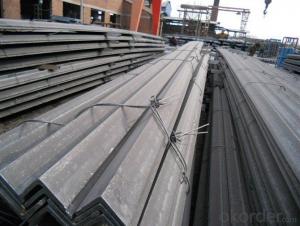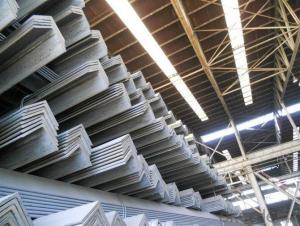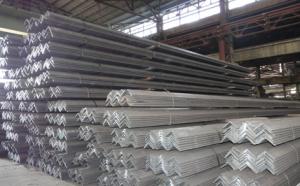Wholesale 2015 Hot Rolled Angle Steel inLarge Stock
- Loading Port:
- Tianjin
- Payment Terms:
- TT OR LC
- Min Order Qty:
- 25 m.t.
- Supply Capability:
- 20000 m.t./month
OKorder Service Pledge
OKorder Financial Service
You Might Also Like
Specification
OKorder is offering high quality Hot Rolled Steel Angle at great prices with worldwide shipping. Our supplier is a world-class manufacturer of steel, with our products utilized the world over. OKorder annually supplies products to European, North American and Asian markets. We provide quotations within 24 hours of receiving an inquiry and guarantee competitive prices.
Product Applications:
Hot Rolled Steel Angles are ideal for structural applications and are widely used in the construction of buildings and bridges, and the manufacturing, petrochemical, and transportation industries.
Product Advantages:
OKorder's Steel Angles are durable, strong, and resist corrosion.
Main Product Features:
· Premium quality
· Prompt delivery & seaworthy packing (30 days after receiving deposit)
· Corrosion resistance
· Can be recycled and reused
· Mill test certification
· Professional Service
· Competitive pricing
Product Specifications:
Manufacture: Hot rolled
Grade: Q195 – 235
Certificates: ISO, SGS, BV, CIQ
Length: 6m – 12m, as per customer request
Packaging: Export packing, nude packing, bundled
Sizes: 25mm-250mm | ||
a*t | ||
25*2.5-4.0 | 70*6.0-9.0 | 130*9.0-15 |
30*2.5-6.6 | 75*6.0-9.0 | 140*10-14 |
36*3.0-5.0 | 80*5.0-10 | 150*10-20 |
38*2.3-6.0 | 90*7.0-10 | 160*10-16 |
40*3.0-5.0 | 100*6.0-12 | 175*12-15 |
45*4.0-6.0 | 110*8.0-10 | 180*12-18 |
50*4.0-6.0 | 120*6.0-15 | 200*14-25 |
60*4.0-8.0 | 125*8.0-14 | 250*25 |
FAQ:
Q1: Why buy Materials & Equipment from OKorder.com?
A1: All products offered byOKorder.com are carefully selected from China's most reliable manufacturing enterprises. Through its ISO certifications, OKorder.com adheres to the highest standards and a commitment to supply chain safety and customer satisfaction.
Q2: How do we guarantee the quality of our products?
A2: We have established an advanced quality management system which conducts strict quality tests at every step, from raw materials to the final product. At the same time, we provide extensive follow-up service assurances as required.
Q3: How soon can we receive the product after purchase?
A3: Within three days of placing an order, we will begin production. The specific shipping date is dependent upon international and government factors, but is typically 7 to 10 workdays.
Alloy No | Grade | Element (%) | |||||
C | Mn | S | P | Si | |||
Q235 | B | 0.12—0.20 | 0.3—0.7 | ≤0.045 | ≤0.045 | ≤0.3 | |
Alloy No | Grade | Yielding strength point( Mpa) | |||||
Thickness (mm) | |||||||
≤16 | >16--40 | >40--60 | >60--100 | ||||
≥ | |||||||
Q235 | B | 235 | 225 | 215 | 205 | ||
Alloy No | Grade | Tensile strength (Mpa) | Elongation after fracture (%) | ||||
Thickness (mm) | |||||||
≤16 | >16--40 | >40--60 | >60--100 | ||||
≥ | |||||||
Q235 | B | 375--500 | 26 | 25 | 24 | 23 | |
Images:
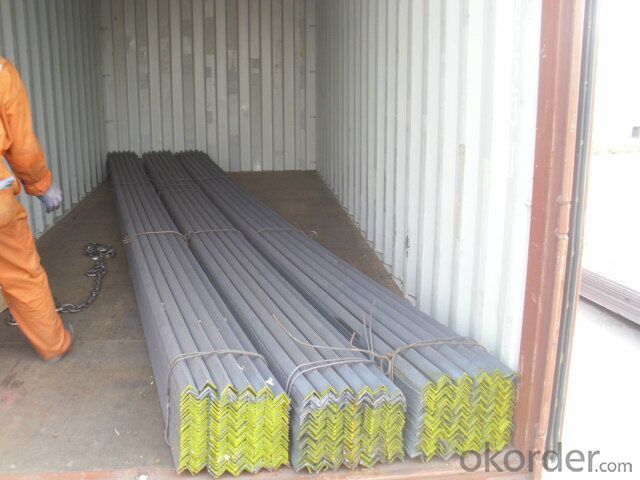
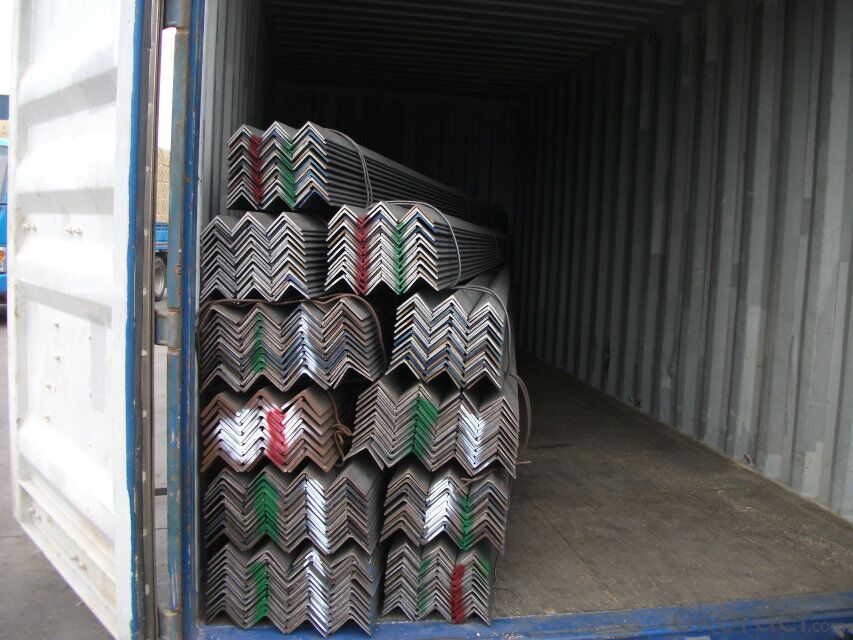
- Q: What are the different methods of cutting steel angles?
- There are several methods used for cutting steel angles, depending on the specific requirements and resources available. Some of the commonly used methods include: 1. Saw cutting: This method involves using a circular saw or bandsaw equipped with a metal cutting blade. It provides a clean and precise cut, especially for smaller angles. 2. Laser cutting: Laser cutting is a highly accurate and efficient method that uses a focused laser beam to melt or vaporize the steel angle. It is ideal for complex shapes and intricate designs. 3. Plasma cutting: Plasma cutting utilizes a high-temperature plasma arc to melt the metal and blow away the molten material. It is a versatile method suitable for cutting thicker steel angles. 4. Waterjet cutting: Waterjet cutting involves using a high-pressure jet of water mixed with abrasive particles to erode the steel angle. This method is excellent for cutting thick angles and creating intricate patterns. 5. Shearing: Shearing is a process that involves using a machine with a sharp blade to cut through the steel angle. It is commonly used for straight cuts and is suitable for thinner angles. 6. Abrasive cutting: Abrasive cutting utilizes a rotary wheel embedded with abrasive particles to cut through the steel angle. It is a relatively fast and cost-effective method, but it may result in a rougher cut surface. 7. Flame cutting: Flame cutting, also known as oxy-fuel cutting, uses a mixture of fuel gas and oxygen to create a high-temperature flame, which melts the steel angle. It is suitable for cutting thicker angles but may result in a heat-affected zone. Each cutting method has its advantages and limitations, and the choice of method depends on factors such as the angle's thickness, complexity of the cut, desired precision, and available equipment. It is essential to consider safety precautions and choose the most appropriate method to ensure a successful and efficient steel angle cutting process.
- Q: What is the fire resistance rating of steel angles?
- The fire resistance of steel angles relies on several factors, including the angle's size and thickness, the type of steel employed, and the specific fire protection measures implemented. Steel possesses inherent fire resistance due to its high melting point and low thermal conductivity. Nevertheless, the fire resistance can be improved by applying fireproofing materials, such as intumescent coatings or fire-resistant boards, to the steel angles. By providing insulation and slowing down heat transfer to the steel, these fire protection measures can significantly augment the fire resistance of steel angles. The specific fire resistance rating may differ depending on the thickness and type of fireproofing materials employed. For instance, a steel angle coated with a particular fireproofing substance may have a fire resistance rating of 60 minutes, signifying its ability to withstand fire exposure for up to 60 minutes without compromising its structural integrity. To determine the specific fire resistance requirements for steel angles in a specific application, it is crucial to refer to local building codes, regulations, and fire safety standards. These standards can offer guidance on the necessary fire protection measures and the minimum fire resistance ratings that must be met in different construction scenarios.
- Q: How are steel angles installed or fixed in place?
- Steel angles can be installed or fixed in place using various methods such as welding, bolting, or using adhesive agents. Welding involves melting the steel angle and the surface it is being fixed to, and then fusing them together. Bolting involves using bolts and nuts to secure the steel angle to the desired surface. Adhesive agents can also be used to bond the steel angle to the surface. The specific method chosen depends on the requirements of the installation and the strength and stability needed.
- Q: What is the maximum allowable tensile stress for a steel angle?
- The maximum allowable tensile stress for a steel angle depends on various factors such as the specific grade of steel, the manufacturing process, and the intended application. Steel angles are commonly used in construction and structural applications, and their maximum allowable tensile stress is typically determined by industry standards and design codes. For example, in the United States, the American Institute of Steel Construction (AISC) provides design specifications for structural steel angles. According to AISC, the maximum allowable tensile stress for a steel angle is typically based on the yield strength of the steel material. The yield strength refers to the stress at which a material begins to deform permanently. It is usually specified in terms of pounds per square inch (psi) or megapascals (MPa). Steel angles are typically designed to operate within a certain percentage of their yield strength to ensure structural integrity and safety. In general, the maximum allowable tensile stress for a steel angle is often limited to a percentage of its yield strength, typically ranging from 50% to 70%. This means that the maximum tensile stress that can be applied to a steel angle is a fraction of its yield strength. It is crucial to consult the appropriate design standards and codes, such as those provided by AISC or other relevant organizations, to determine the specific maximum allowable tensile stress for a given steel angle in a particular application. These standards consider factors such as load conditions, safety factors, and environmental conditions to ensure the structural integrity and reliability of the steel angle.
- Q: Can steel angles be used in bridge construction?
- Yes, steel angles can definitely be used in bridge construction. Steel angles, also known as L-shaped structural steel, are commonly used as cross-sectional supports in bridge construction. They are particularly useful for providing stability, strength, and rigidity to bridge structures. Steel angles are versatile and can be used for various bridge components such as beams, trusses, and bracing systems. They are often welded or bolted together to form structural connections, ensuring the integrity and load-carrying capacity of the bridge. Steel angles offer several advantages in bridge construction, including their high strength-to-weight ratio, durability, and resistance to corrosion. Overall, steel angles are a reliable and widely used component in the construction of bridges.
- Q: How do you prevent galvanic corrosion in steel angles?
- To prevent galvanic corrosion in steel angles, there are a few measures that can be taken. 1. Proper coating: Applying a protective coating such as paint, epoxy, or galvanization can create a barrier between the steel angle and other metals. This prevents direct contact and minimizes the risk of galvanic corrosion. 2. Insulation: Using insulation materials such as rubber or plastic washers, gaskets, or sleeves can help isolate the steel angle from other metals. This prevents the flow of electrical currents and reduces the chances of galvanic corrosion. 3. Proper design considerations: When designing structures or systems that involve steel angles, it is important to consider the compatibility of different metals. Pairing metals with similar electrochemical properties can help minimize the risk of galvanic corrosion. 4. Regular maintenance: Regular inspections and maintenance of steel angles can help identify and address early signs of galvanic corrosion. This includes checking for any damage to the protective coating, ensuring proper insulation, and applying appropriate remedies if corrosion is detected. By implementing these preventive measures, the risk of galvanic corrosion in steel angles can be significantly reduced, ensuring their longevity and structural integrity.
- Q: What are the different methods for strengthening steel angles?
- Different techniques can be employed to enhance the strength of steel angles, based on the specific necessities and intended uses. The following are several commonly used methods: 1. Heat treatment: To increase the hardness and strength of steel angles, heat treatment processes such as quenching and tempering are frequently employed. Quenching involves rapidly cooling the steel angle after heating it to a high temperature, while tempering includes reheating the quenched steel angle to a lower temperature. These processes minimize brittleness and improve toughness. 2. Alloying: By introducing certain alloying elements like chromium, molybdenum, or nickel, the strength and hardness of steel angles can be significantly augmented. These alloying elements form solid solutions with the iron matrix, leading to enhanced mechanical properties and resistance to wear or corrosion. 3. Cold working: The strength and hardness of steel angles can be increased through cold working techniques such as cold rolling, cold drawing, or cold forming. These approaches involve deforming the steel angle at room temperature, creating dislocations in the crystal structure and boosting its strength. 4. Welding: Strengthening steel angles can be achieved by employing welding methods like fusion welding or spot welding to join them with other steel components. The weld joint often provides additional strength and rigidity to the steel angle structure. 5. Surface treatments: Employing various surface treatments such as galvanizing, powder coating, or painting can improve the corrosion resistance of steel angles, thereby increasing their durability and overall strength. It should be noted that the selection of the appropriate method for strengthening steel angles relies on factors such as the specific steel grade, intended application, and desired mechanical properties. Consulting with a professional engineer or metallurgist is advisable to determine the most suitable method for a particular scenario.
- Q: Are steel angles suitable for manufacturing support brackets for conduits?
- Steel angles are indeed a suitable choice for the production of support brackets for conduits. In the realms of construction and manufacturing, steel angles are widely employed owing to their robustness and resilience. They offer exceptional structural reinforcement and possess the ability to endure substantial loads. Utilizing steel angles in the creation of support brackets for conduits guarantees the secure and steadfast positioning of said conduits, thereby averting any prospective harm or mishaps. Furthermore, steel angles can be readily tailored to meet particular criteria, including dimensions, configurations, and surface treatments, rendering them an adaptable option for the fabrication of support brackets for conduits.
- Q: Can steel angles be used in construction?
- Indeed, construction can utilize steel angles. Due to their versatility, strength, and cost-effectiveness, steel angles are frequently employed as structural elements in construction endeavors. Their primary purpose is to support and reinforce various structural components, including beams, columns, and walls. Various sizes and thicknesses of steel angles are available, allowing for a wide range of applications in construction. They can be easily joined together through welding, bolting, or fastening, facilitating convenient on-site installation and customization. A key advantage of incorporating steel angles in construction lies in their high strength-to-weight ratio. This attribute enables steel angles to possess outstanding load-bearing capacity while remaining relatively lightweight, rendering them highly suitable for structures that necessitate strength without excessive weight. Moreover, steel angles exhibit excellent durability and resistance against environmental factors such as corrosion, fire, and pests. Consequently, structures constructed with steel angles boast extended lifespans and require minimal maintenance over time. In summary, steel angles offer a versatile and dependable option for construction projects, regardless of whether they are residential, commercial, or industrial in nature. Architects, engineers, and contractors commonly favor steel angles due to their strength, durability, and ease of installation.
- Q: What are the different shapes available for steel angles?
- The different shapes available for steel angles include equal angles, unequal angles, and L-shaped angles.
Send your message to us
Wholesale 2015 Hot Rolled Angle Steel inLarge Stock
- Loading Port:
- Tianjin
- Payment Terms:
- TT OR LC
- Min Order Qty:
- 25 m.t.
- Supply Capability:
- 20000 m.t./month
OKorder Service Pledge
OKorder Financial Service
Similar products
Hot products
Hot Searches
Related keywords
